Commercial Law | Business structures: Advantages and Disadvantages
VerifiedAdded on 2022/09/07
|6
|1676
|57
AI Summary
Contribute Materials
Your contribution can guide someone’s learning journey. Share your
documents today.

COMMERCIAL LAW
Secure Best Marks with AI Grader
Need help grading? Try our AI Grader for instant feedback on your assignments.
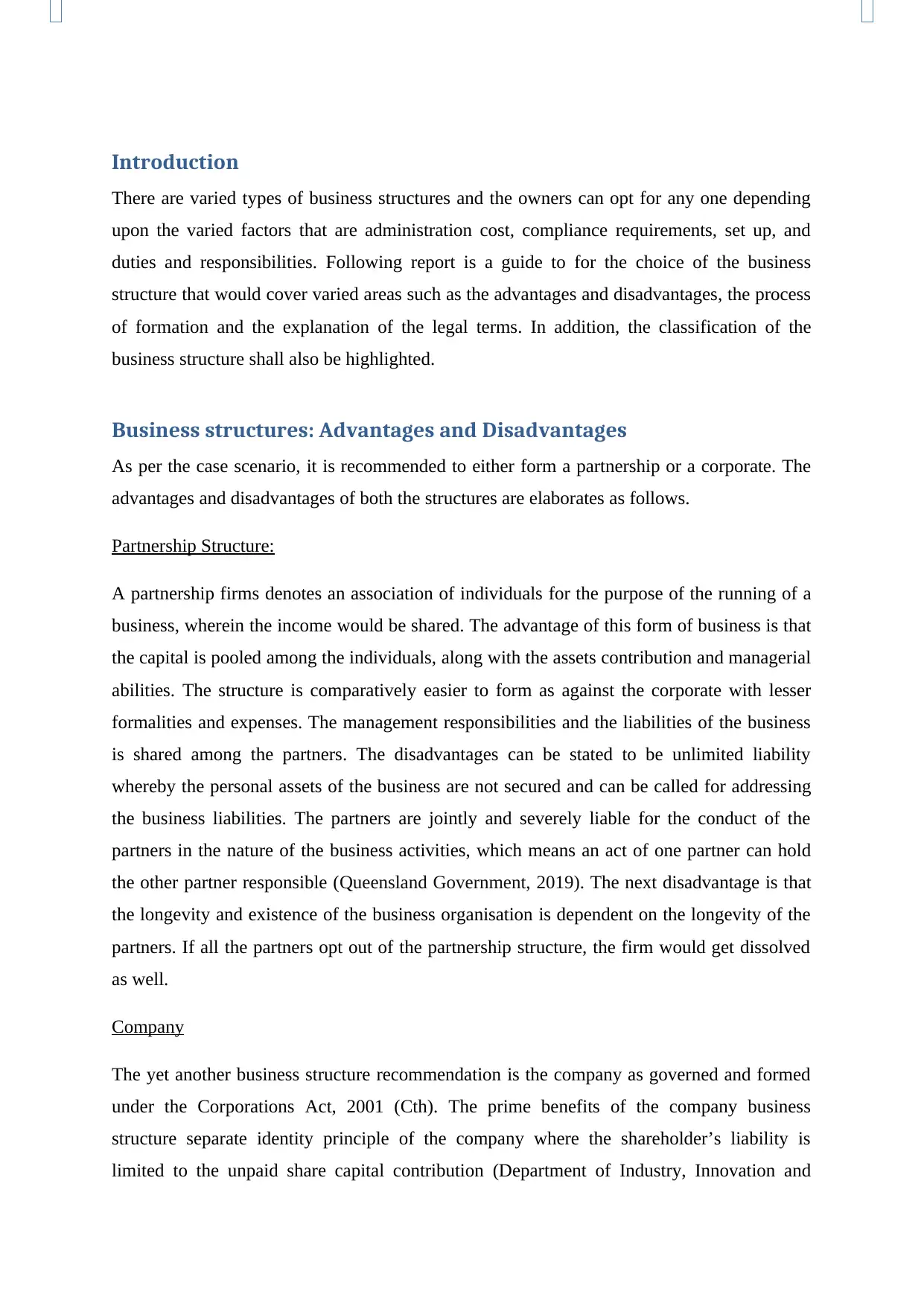
Introduction
There are varied types of business structures and the owners can opt for any one depending
upon the varied factors that are administration cost, compliance requirements, set up, and
duties and responsibilities. Following report is a guide to for the choice of the business
structure that would cover varied areas such as the advantages and disadvantages, the process
of formation and the explanation of the legal terms. In addition, the classification of the
business structure shall also be highlighted.
Business structures: Advantages and Disadvantages
As per the case scenario, it is recommended to either form a partnership or a corporate. The
advantages and disadvantages of both the structures are elaborates as follows.
Partnership Structure:
A partnership firms denotes an association of individuals for the purpose of the running of a
business, wherein the income would be shared. The advantage of this form of business is that
the capital is pooled among the individuals, along with the assets contribution and managerial
abilities. The structure is comparatively easier to form as against the corporate with lesser
formalities and expenses. The management responsibilities and the liabilities of the business
is shared among the partners. The disadvantages can be stated to be unlimited liability
whereby the personal assets of the business are not secured and can be called for addressing
the business liabilities. The partners are jointly and severely liable for the conduct of the
partners in the nature of the business activities, which means an act of one partner can hold
the other partner responsible (Queensland Government, 2019). The next disadvantage is that
the longevity and existence of the business organisation is dependent on the longevity of the
partners. If all the partners opt out of the partnership structure, the firm would get dissolved
as well.
Company
The yet another business structure recommendation is the company as governed and formed
under the Corporations Act, 2001 (Cth). The prime benefits of the company business
structure separate identity principle of the company where the shareholder’s liability is
limited to the unpaid share capital contribution (Department of Industry, Innovation and
There are varied types of business structures and the owners can opt for any one depending
upon the varied factors that are administration cost, compliance requirements, set up, and
duties and responsibilities. Following report is a guide to for the choice of the business
structure that would cover varied areas such as the advantages and disadvantages, the process
of formation and the explanation of the legal terms. In addition, the classification of the
business structure shall also be highlighted.
Business structures: Advantages and Disadvantages
As per the case scenario, it is recommended to either form a partnership or a corporate. The
advantages and disadvantages of both the structures are elaborates as follows.
Partnership Structure:
A partnership firms denotes an association of individuals for the purpose of the running of a
business, wherein the income would be shared. The advantage of this form of business is that
the capital is pooled among the individuals, along with the assets contribution and managerial
abilities. The structure is comparatively easier to form as against the corporate with lesser
formalities and expenses. The management responsibilities and the liabilities of the business
is shared among the partners. The disadvantages can be stated to be unlimited liability
whereby the personal assets of the business are not secured and can be called for addressing
the business liabilities. The partners are jointly and severely liable for the conduct of the
partners in the nature of the business activities, which means an act of one partner can hold
the other partner responsible (Queensland Government, 2019). The next disadvantage is that
the longevity and existence of the business organisation is dependent on the longevity of the
partners. If all the partners opt out of the partnership structure, the firm would get dissolved
as well.
Company
The yet another business structure recommendation is the company as governed and formed
under the Corporations Act, 2001 (Cth). The prime benefits of the company business
structure separate identity principle of the company where the shareholder’s liability is
limited to the unpaid share capital contribution (Department of Industry, Innovation and
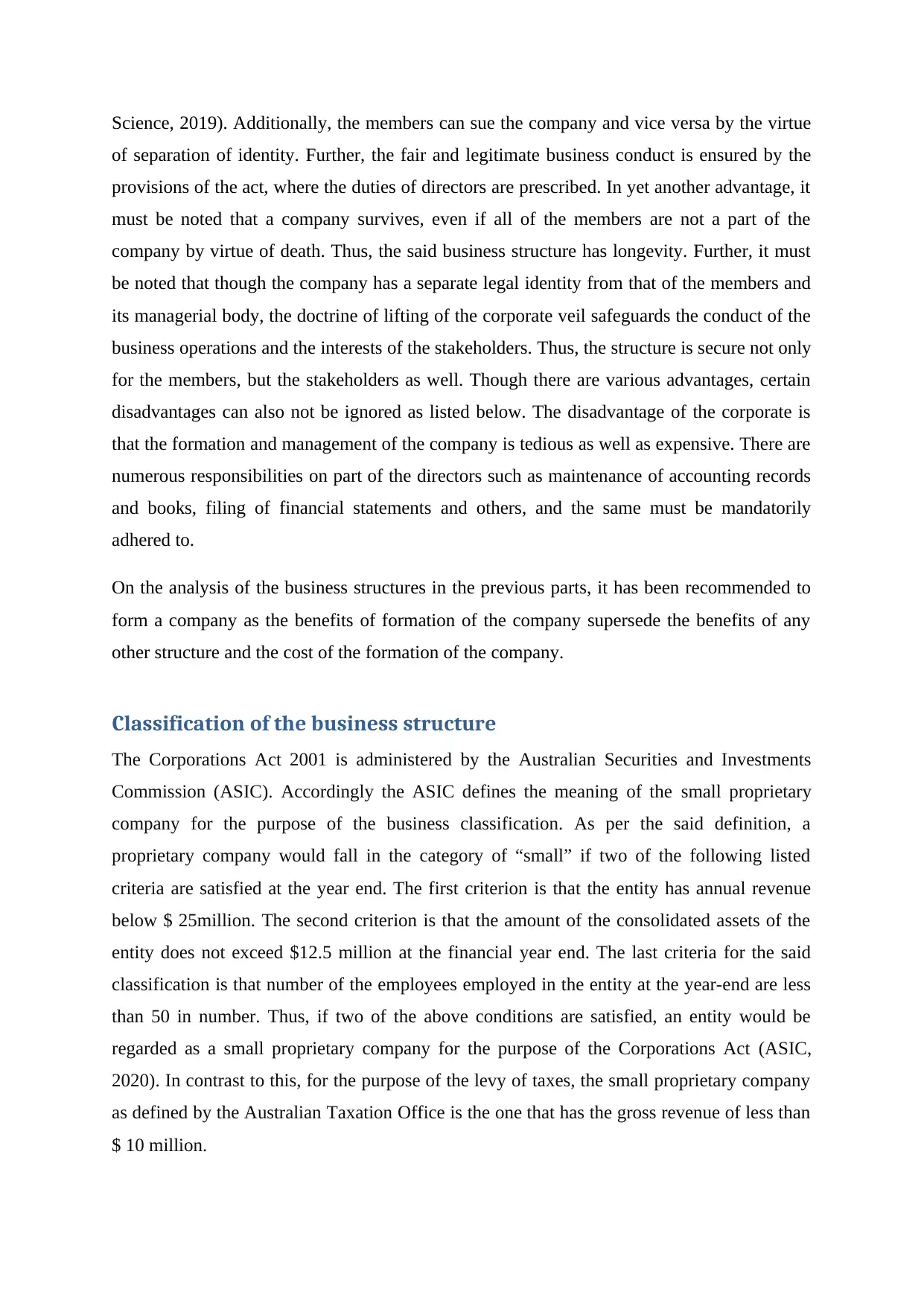
Science, 2019). Additionally, the members can sue the company and vice versa by the virtue
of separation of identity. Further, the fair and legitimate business conduct is ensured by the
provisions of the act, where the duties of directors are prescribed. In yet another advantage, it
must be noted that a company survives, even if all of the members are not a part of the
company by virtue of death. Thus, the said business structure has longevity. Further, it must
be noted that though the company has a separate legal identity from that of the members and
its managerial body, the doctrine of lifting of the corporate veil safeguards the conduct of the
business operations and the interests of the stakeholders. Thus, the structure is secure not only
for the members, but the stakeholders as well. Though there are various advantages, certain
disadvantages can also not be ignored as listed below. The disadvantage of the corporate is
that the formation and management of the company is tedious as well as expensive. There are
numerous responsibilities on part of the directors such as maintenance of accounting records
and books, filing of financial statements and others, and the same must be mandatorily
adhered to.
On the analysis of the business structures in the previous parts, it has been recommended to
form a company as the benefits of formation of the company supersede the benefits of any
other structure and the cost of the formation of the company.
Classification of the business structure
The Corporations Act 2001 is administered by the Australian Securities and Investments
Commission (ASIC). Accordingly the ASIC defines the meaning of the small proprietary
company for the purpose of the business classification. As per the said definition, a
proprietary company would fall in the category of “small” if two of the following listed
criteria are satisfied at the year end. The first criterion is that the entity has annual revenue
below $ 25million. The second criterion is that the amount of the consolidated assets of the
entity does not exceed $12.5 million at the financial year end. The last criteria for the said
classification is that number of the employees employed in the entity at the year-end are less
than 50 in number. Thus, if two of the above conditions are satisfied, an entity would be
regarded as a small proprietary company for the purpose of the Corporations Act (ASIC,
2020). In contrast to this, for the purpose of the levy of taxes, the small proprietary company
as defined by the Australian Taxation Office is the one that has the gross revenue of less than
$ 10 million.
of separation of identity. Further, the fair and legitimate business conduct is ensured by the
provisions of the act, where the duties of directors are prescribed. In yet another advantage, it
must be noted that a company survives, even if all of the members are not a part of the
company by virtue of death. Thus, the said business structure has longevity. Further, it must
be noted that though the company has a separate legal identity from that of the members and
its managerial body, the doctrine of lifting of the corporate veil safeguards the conduct of the
business operations and the interests of the stakeholders. Thus, the structure is secure not only
for the members, but the stakeholders as well. Though there are various advantages, certain
disadvantages can also not be ignored as listed below. The disadvantage of the corporate is
that the formation and management of the company is tedious as well as expensive. There are
numerous responsibilities on part of the directors such as maintenance of accounting records
and books, filing of financial statements and others, and the same must be mandatorily
adhered to.
On the analysis of the business structures in the previous parts, it has been recommended to
form a company as the benefits of formation of the company supersede the benefits of any
other structure and the cost of the formation of the company.
Classification of the business structure
The Corporations Act 2001 is administered by the Australian Securities and Investments
Commission (ASIC). Accordingly the ASIC defines the meaning of the small proprietary
company for the purpose of the business classification. As per the said definition, a
proprietary company would fall in the category of “small” if two of the following listed
criteria are satisfied at the year end. The first criterion is that the entity has annual revenue
below $ 25million. The second criterion is that the amount of the consolidated assets of the
entity does not exceed $12.5 million at the financial year end. The last criteria for the said
classification is that number of the employees employed in the entity at the year-end are less
than 50 in number. Thus, if two of the above conditions are satisfied, an entity would be
regarded as a small proprietary company for the purpose of the Corporations Act (ASIC,
2020). In contrast to this, for the purpose of the levy of taxes, the small proprietary company
as defined by the Australian Taxation Office is the one that has the gross revenue of less than
$ 10 million.
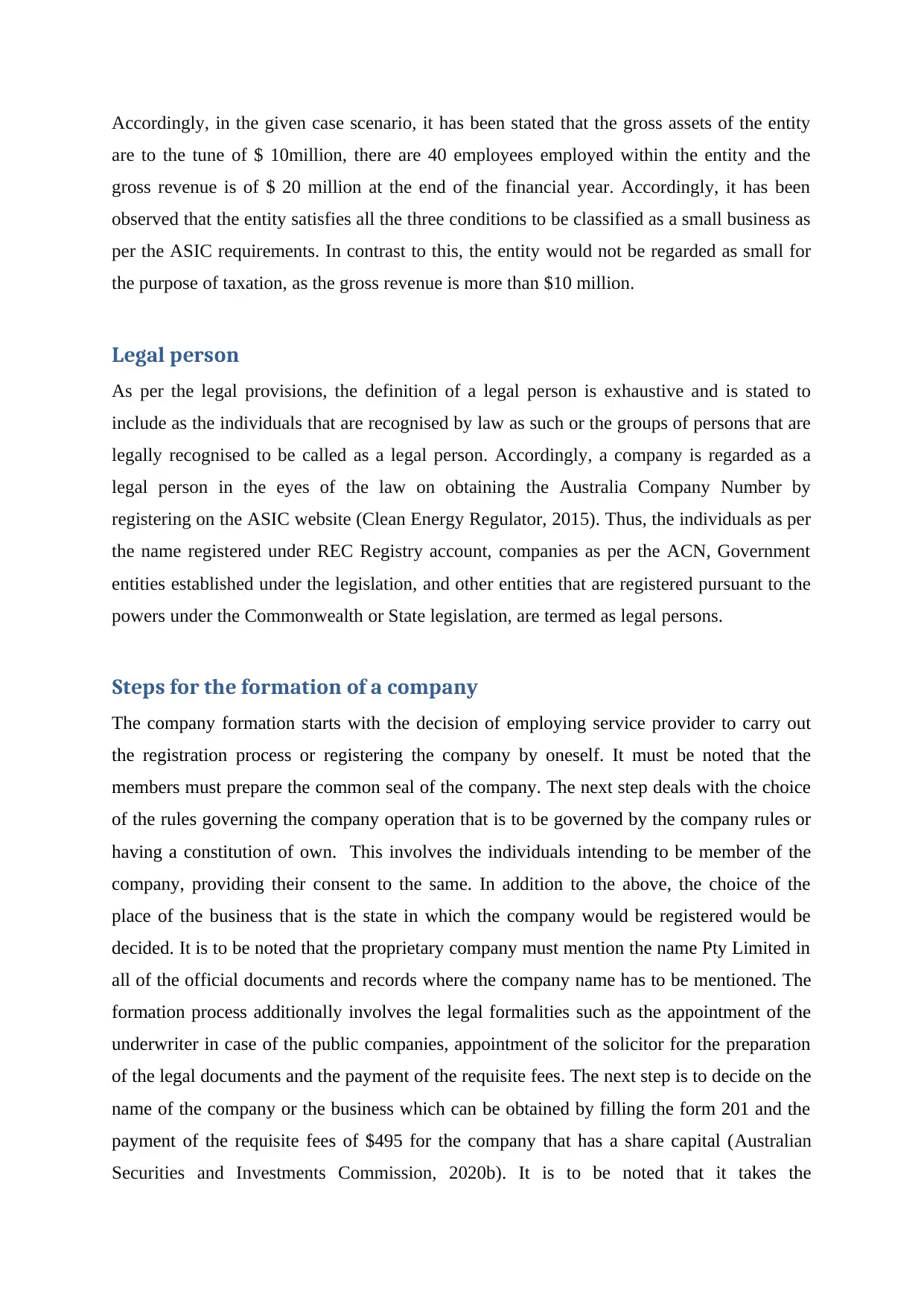
Accordingly, in the given case scenario, it has been stated that the gross assets of the entity
are to the tune of $ 10million, there are 40 employees employed within the entity and the
gross revenue is of $ 20 million at the end of the financial year. Accordingly, it has been
observed that the entity satisfies all the three conditions to be classified as a small business as
per the ASIC requirements. In contrast to this, the entity would not be regarded as small for
the purpose of taxation, as the gross revenue is more than $10 million.
Legal person
As per the legal provisions, the definition of a legal person is exhaustive and is stated to
include as the individuals that are recognised by law as such or the groups of persons that are
legally recognised to be called as a legal person. Accordingly, a company is regarded as a
legal person in the eyes of the law on obtaining the Australia Company Number by
registering on the ASIC website (Clean Energy Regulator, 2015). Thus, the individuals as per
the name registered under REC Registry account, companies as per the ACN, Government
entities established under the legislation, and other entities that are registered pursuant to the
powers under the Commonwealth or State legislation, are termed as legal persons.
Steps for the formation of a company
The company formation starts with the decision of employing service provider to carry out
the registration process or registering the company by oneself. It must be noted that the
members must prepare the common seal of the company. The next step deals with the choice
of the rules governing the company operation that is to be governed by the company rules or
having a constitution of own. This involves the individuals intending to be member of the
company, providing their consent to the same. In addition to the above, the choice of the
place of the business that is the state in which the company would be registered would be
decided. It is to be noted that the proprietary company must mention the name Pty Limited in
all of the official documents and records where the company name has to be mentioned. The
formation process additionally involves the legal formalities such as the appointment of the
underwriter in case of the public companies, appointment of the solicitor for the preparation
of the legal documents and the payment of the requisite fees. The next step is to decide on the
name of the company or the business which can be obtained by filling the form 201 and the
payment of the requisite fees of $495 for the company that has a share capital (Australian
Securities and Investments Commission, 2020b). It is to be noted that it takes the
are to the tune of $ 10million, there are 40 employees employed within the entity and the
gross revenue is of $ 20 million at the end of the financial year. Accordingly, it has been
observed that the entity satisfies all the three conditions to be classified as a small business as
per the ASIC requirements. In contrast to this, the entity would not be regarded as small for
the purpose of taxation, as the gross revenue is more than $10 million.
Legal person
As per the legal provisions, the definition of a legal person is exhaustive and is stated to
include as the individuals that are recognised by law as such or the groups of persons that are
legally recognised to be called as a legal person. Accordingly, a company is regarded as a
legal person in the eyes of the law on obtaining the Australia Company Number by
registering on the ASIC website (Clean Energy Regulator, 2015). Thus, the individuals as per
the name registered under REC Registry account, companies as per the ACN, Government
entities established under the legislation, and other entities that are registered pursuant to the
powers under the Commonwealth or State legislation, are termed as legal persons.
Steps for the formation of a company
The company formation starts with the decision of employing service provider to carry out
the registration process or registering the company by oneself. It must be noted that the
members must prepare the common seal of the company. The next step deals with the choice
of the rules governing the company operation that is to be governed by the company rules or
having a constitution of own. This involves the individuals intending to be member of the
company, providing their consent to the same. In addition to the above, the choice of the
place of the business that is the state in which the company would be registered would be
decided. It is to be noted that the proprietary company must mention the name Pty Limited in
all of the official documents and records where the company name has to be mentioned. The
formation process additionally involves the legal formalities such as the appointment of the
underwriter in case of the public companies, appointment of the solicitor for the preparation
of the legal documents and the payment of the requisite fees. The next step is to decide on the
name of the company or the business which can be obtained by filling the form 201 and the
payment of the requisite fees of $495 for the company that has a share capital (Australian
Securities and Investments Commission, 2020b). It is to be noted that it takes the
Secure Best Marks with AI Grader
Need help grading? Try our AI Grader for instant feedback on your assignments.
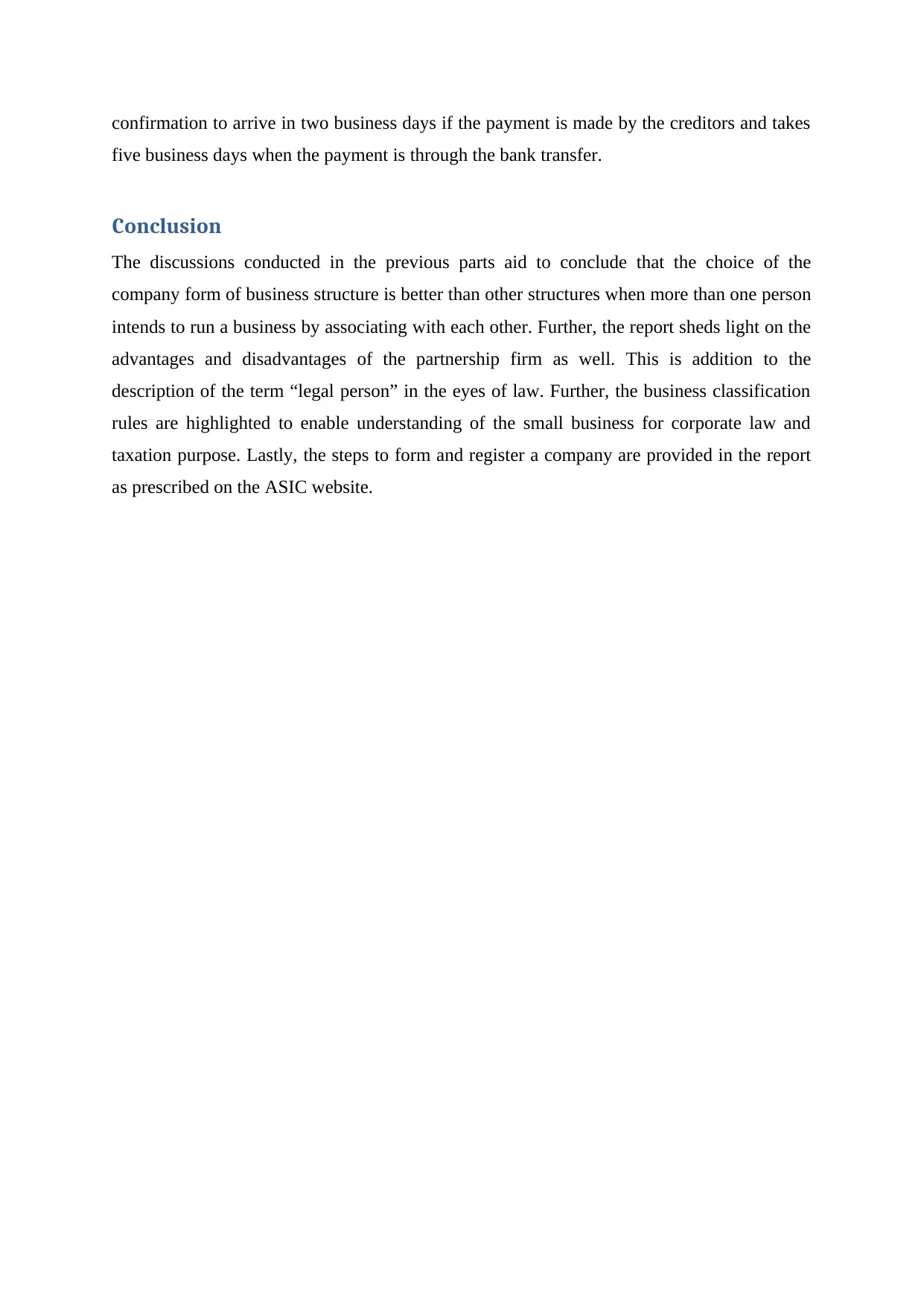
confirmation to arrive in two business days if the payment is made by the creditors and takes
five business days when the payment is through the bank transfer.
Conclusion
The discussions conducted in the previous parts aid to conclude that the choice of the
company form of business structure is better than other structures when more than one person
intends to run a business by associating with each other. Further, the report sheds light on the
advantages and disadvantages of the partnership firm as well. This is addition to the
description of the term “legal person” in the eyes of law. Further, the business classification
rules are highlighted to enable understanding of the small business for corporate law and
taxation purpose. Lastly, the steps to form and register a company are provided in the report
as prescribed on the ASIC website.
five business days when the payment is through the bank transfer.
Conclusion
The discussions conducted in the previous parts aid to conclude that the choice of the
company form of business structure is better than other structures when more than one person
intends to run a business by associating with each other. Further, the report sheds light on the
advantages and disadvantages of the partnership firm as well. This is addition to the
description of the term “legal person” in the eyes of law. Further, the business classification
rules are highlighted to enable understanding of the small business for corporate law and
taxation purpose. Lastly, the steps to form and register a company are provided in the report
as prescribed on the ASIC website.
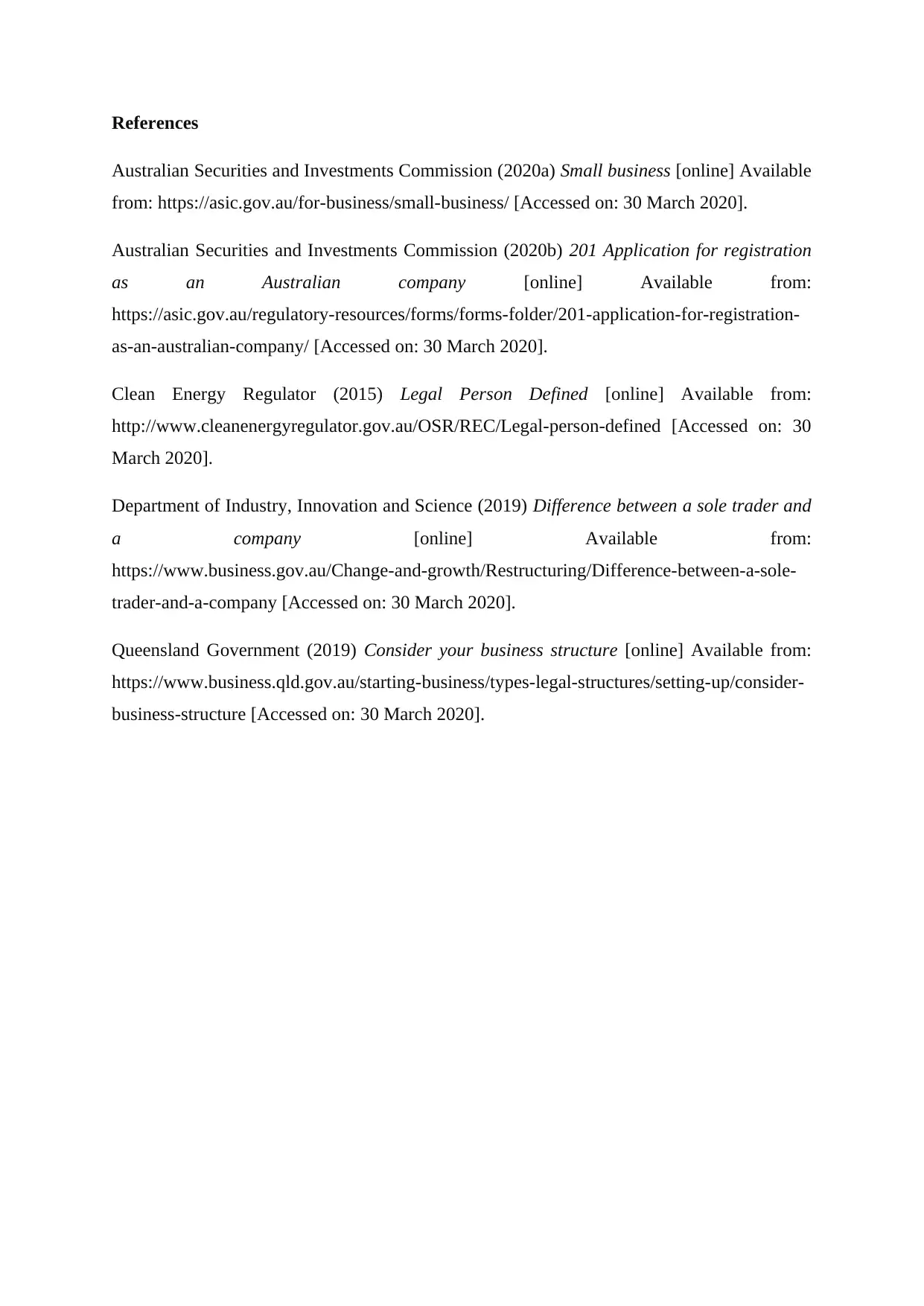
References
Australian Securities and Investments Commission (2020a) Small business [online] Available
from: https://asic.gov.au/for-business/small-business/ [Accessed on: 30 March 2020].
Australian Securities and Investments Commission (2020b) 201 Application for registration
as an Australian company [online] Available from:
https://asic.gov.au/regulatory-resources/forms/forms-folder/201-application-for-registration-
as-an-australian-company/ [Accessed on: 30 March 2020].
Clean Energy Regulator (2015) Legal Person Defined [online] Available from:
http://www.cleanenergyregulator.gov.au/OSR/REC/Legal-person-defined [Accessed on: 30
March 2020].
Department of Industry, Innovation and Science (2019) Difference between a sole trader and
a company [online] Available from:
https://www.business.gov.au/Change-and-growth/Restructuring/Difference-between-a-sole-
trader-and-a-company [Accessed on: 30 March 2020].
Queensland Government (2019) Consider your business structure [online] Available from:
https://www.business.qld.gov.au/starting-business/types-legal-structures/setting-up/consider-
business-structure [Accessed on: 30 March 2020].
Australian Securities and Investments Commission (2020a) Small business [online] Available
from: https://asic.gov.au/for-business/small-business/ [Accessed on: 30 March 2020].
Australian Securities and Investments Commission (2020b) 201 Application for registration
as an Australian company [online] Available from:
https://asic.gov.au/regulatory-resources/forms/forms-folder/201-application-for-registration-
as-an-australian-company/ [Accessed on: 30 March 2020].
Clean Energy Regulator (2015) Legal Person Defined [online] Available from:
http://www.cleanenergyregulator.gov.au/OSR/REC/Legal-person-defined [Accessed on: 30
March 2020].
Department of Industry, Innovation and Science (2019) Difference between a sole trader and
a company [online] Available from:
https://www.business.gov.au/Change-and-growth/Restructuring/Difference-between-a-sole-
trader-and-a-company [Accessed on: 30 March 2020].
Queensland Government (2019) Consider your business structure [online] Available from:
https://www.business.qld.gov.au/starting-business/types-legal-structures/setting-up/consider-
business-structure [Accessed on: 30 March 2020].
1 out of 6
Related Documents
Your All-in-One AI-Powered Toolkit for Academic Success.
+13062052269
info@desklib.com
Available 24*7 on WhatsApp / Email
![[object Object]](/_next/static/media/star-bottom.7253800d.svg)
Unlock your academic potential
© 2024 | Zucol Services PVT LTD | All rights reserved.





